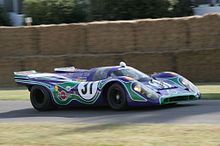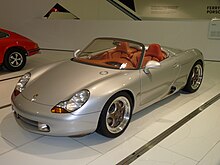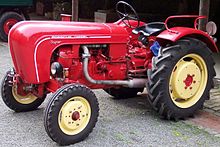Founded: April 25, 1931, Stuttgart, Germany
Dr. Ing. h.c. F. Porsche AG, usually shortened to Porsche AG, is a German automobile manufacturer specializing in high-performance sports cars, SUVs and sedans. Porsche AG is headquartered in Stuttgart, and is owned by Volkswagen AG, which is itself majority-owned by Porsche Automobil Holding SE. Porsche's current lineup includes the 911, Boxster, Cayman, Panamera, Cayenne, Macan, and the 918.
 | ||||||||||||||||||||||||||||||||||||||||||||||||||||||||||||||||||||||||||||||||||||||||||||||||||||||||||||||||||||||||||||||||||||||||||||||||||||||||||||||||||||||||||||||||||||||||||||||||||||||||||||||||||||||||||||||||||||||||||||||||||||||||||||||||
| Aktiengesellschaft | ||||||||||||||||||||||||||||||||||||||||||||||||||||||||||||||||||||||||||||||||||||||||||||||||||||||||||||||||||||||||||||||||||||||||||||||||||||||||||||||||||||||||||||||||||||||||||||||||||||||||||||||||||||||||||||||||||||||||||||||||||||||||||||||||
| Industry | Automotive | |||||||||||||||||||||||||||||||||||||||||||||||||||||||||||||||||||||||||||||||||||||||||||||||||||||||||||||||||||||||||||||||||||||||||||||||||||||||||||||||||||||||||||||||||||||||||||||||||||||||||||||||||||||||||||||||||||||||||||||||||||||||||||||||
| Founded | Stuttgart, Germany (1931) | |||||||||||||||||||||||||||||||||||||||||||||||||||||||||||||||||||||||||||||||||||||||||||||||||||||||||||||||||||||||||||||||||||||||||||||||||||||||||||||||||||||||||||||||||||||||||||||||||||||||||||||||||||||||||||||||||||||||||||||||||||||||||||||||
| Founder | Ferdinand Porsche | |||||||||||||||||||||||||||||||||||||||||||||||||||||||||||||||||||||||||||||||||||||||||||||||||||||||||||||||||||||||||||||||||||||||||||||||||||||||||||||||||||||||||||||||||||||||||||||||||||||||||||||||||||||||||||||||||||||||||||||||||||||||||||||||
| Headquarters | Stuttgart, Baden-Württemberg, Germany | |||||||||||||||||||||||||||||||||||||||||||||||||||||||||||||||||||||||||||||||||||||||||||||||||||||||||||||||||||||||||||||||||||||||||||||||||||||||||||||||||||||||||||||||||||||||||||||||||||||||||||||||||||||||||||||||||||||||||||||||||||||||||||||||
Area served
| Worldwide | |||||||||||||||||||||||||||||||||||||||||||||||||||||||||||||||||||||||||||||||||||||||||||||||||||||||||||||||||||||||||||||||||||||||||||||||||||||||||||||||||||||||||||||||||||||||||||||||||||||||||||||||||||||||||||||||||||||||||||||||||||||||||||||||
Key people
| Wolfgang Porsche, Chairman Oliver Blume, CEO[1] | |||||||||||||||||||||||||||||||||||||||||||||||||||||||||||||||||||||||||||||||||||||||||||||||||||||||||||||||||||||||||||||||||||||||||||||||||||||||||||||||||||||||||||||||||||||||||||||||||||||||||||||||||||||||||||||||||||||||||||||||||||||||||||||||
| Services | Automotive financial services, engineering services, investment management | |||||||||||||||||||||||||||||||||||||||||||||||||||||||||||||||||||||||||||||||||||||||||||||||||||||||||||||||||||||||||||||||||||||||||||||||||||||||||||||||||||||||||||||||||||||||||||||||||||||||||||||||||||||||||||||||||||||||||||||||||||||||||||||||
| Revenue | ||||||||||||||||||||||||||||||||||||||||||||||||||||||||||||||||||||||||||||||||||||||||||||||||||||||||||||||||||||||||||||||||||||||||||||||||||||||||||||||||||||||||||||||||||||||||||||||||||||||||||||||||||||||||||||||||||||||||||||||||||||||||||||||||
| Profit | ||||||||||||||||||||||||||||||||||||||||||||||||||||||||||||||||||||||||||||||||||||||||||||||||||||||||||||||||||||||||||||||||||||||||||||||||||||||||||||||||||||||||||||||||||||||||||||||||||||||||||||||||||||||||||||||||||||||||||||||||||||||||||||||||
| Total assets | ||||||||||||||||||||||||||||||||||||||||||||||||||||||||||||||||||||||||||||||||||||||||||||||||||||||||||||||||||||||||||||||||||||||||||||||||||||||||||||||||||||||||||||||||||||||||||||||||||||||||||||||||||||||||||||||||||||||||||||||||||||||||||||||||
| Total equity | ||||||||||||||||||||||||||||||||||||||||||||||||||||||||||||||||||||||||||||||||||||||||||||||||||||||||||||||||||||||||||||||||||||||||||||||||||||||||||||||||||||||||||||||||||||||||||||||||||||||||||||||||||||||||||||||||||||||||||||||||||||||||||||||||
| Owner | Volkswagen Group | |||||||||||||||||||||||||||||||||||||||||||||||||||||||||||||||||||||||||||||||||||||||||||||||||||||||||||||||||||||||||||||||||||||||||||||||||||||||||||||||||||||||||||||||||||||||||||||||||||||||||||||||||||||||||||||||||||||||||||||||||||||||||||||||
Number of employees
| 19,456 (2013 annual report)[2] | |||||||||||||||||||||||||||||||||||||||||||||||||||||||||||||||||||||||||||||||||||||||||||||||||||||||||||||||||||||||||||||||||||||||||||||||||||||||||||||||||||||||||||||||||||||||||||||||||||||||||||||||||||||||||||||||||||||||||||||||||||||||||||||||
| Subsidiaries | Mieschke Hofmann und Partner (81.8%) Porsche Consulting group HistoryOriginAustrian engineer Ferdinand Porsche founded the company called "Dr. Ing. h. c. F. Porsche GmbH" in Austria in 1931,[4] then moved to its main offices at Kronenstraße 24 in the centre of Stuttgart. Initially, the company offered motor vehicle development work and consulting,[4] but did not build any cars under its own name. One of the first assignments the new company received was from the German government to design a car for the people, that is a "Volkswagen".[4] This resulted in the Volkswagen Beetle, one of the most successful car designs of all time.[5] The Porsche 64 was developed in 1939 using many components from the Beetle.[4]
Panzerjäger Elefant, after the loss of the contract to the Tiger I Porsche recycled his design into a tank destroyer.
At the end of World War II in 1945, the Volkswagen factory at KdF-Stadt fell to the British. Ferdinand lost his position as Chairman of the Board of Management of Volkswagen, and Ivan Hirst, a British Army Major, was put in charge of the factory (in Wolfsburg, the Volkswagen company magazine dubbed him "The British Major who saved Volkswagen").[9] On 15 December of that year, Ferdinand was arrested for war crimes, but not tried. During his 20-month imprisonment, Ferdinand Porsche's son, Ferry Porsche, decided to build his own car, because he could not find an existing one that he wanted to buy. He also had to steer the company through some of its most difficult days until his father's release in August 1947.[10] The first models of what was to become the 356 were built in a small sawmill in Gmünd, Austria.[10] The prototype car was shown to German auto dealers, and when pre-orders reached a set threshold, production (with Aluminium body) was begun by Porsche Konstruktionen GesmbH founded by Ferry and Louise. Many regard the 356 as the first Porsche simply because it was the first model sold by the fledgling company along with Porsche 360. After the production of 356 was taken over by the father's Dr. Ing. h.c. F. Porsche GmbH in Stuttgart in 1950, Porsche commissioned a Zuffenhausen-based company, Reutter Karosserie, which had previously collaborated with the firm on Volkswagen Beetle prototypes, to produce the 356's steel body. In 1952, Porsche constructed an assembly plant (Werk 2) across the street from Reutter Karosserie; the main road in front of Werk 1, the oldest Porsche building, is now known as Porschestrasse.[11] The 356 was road certified in 1948. Company logoWürttemberg-Baden and Württemberg-Hohenzollern became part of the present land of Baden-Württemberg in 1952 after the political consolidation of West Germany in 1949, and the old design of the arms of Württemberg now only lives on in the Porsche logo. On 30 January 1951, not long before the creation of Baden-Württemberg, Ferdinand Porsche died from complications following a stroke. DevelopmentsIn post-war Germany, parts were generally in short supply, so the 356 automobile used components from the Volkswagen Beetle, including the engine case from its internal combustion engine, transmission, and several parts used in the suspension. The 356, however, had several evolutionary stages, A, B, and C, while in production, and most Volkswagen sourced parts were replaced by Porsche-made parts. Beginning in 1954 the 356s engines started utilizing engine cases designed specifically for the 356. The sleek bodywork was designed by Erwin Komenda who also had designed the body of the Beetle. Porsche's signature designs have, from the beginning, featured air-cooled rear-engine configurations (like the Beetle), rare for other car manufacturers, but producing automobiles that are very well balanced.In 1964, after a fair amount of success in motor-racing with various models including the 550 Spyder, and with the 356 needing a major re-design, the company launched the Porsche 911: another air-cooled, rear-engined sports car, this time with a six-cylinder "boxer" engine. The team to lay out the body shell design was led by Ferry Porsche's eldest son, Ferdinand Alexander Porsche (F. A.). The design phase for the 911 caused internal problems with Erwin Komenda, who led the body design department until then. F. A. Porsche complained Komenda made unauthorized changes to the design. Company leader Ferry Porsche took his son's drawings to neighboring chassis manufacturer Reuter. Reuter's workshop was later acquired by Porsche (so-called Werk 2). Afterward Reuter became a seat manufacturer, today known as Keiper-Recaro. 
The Porsche 912, from the 1960s
In 1972, the company's legal form was changed from Kommanditgesellschaft (KG), or limited partnership, to Aktiengesellschaft (AG), or public limited company, because Ferry Porsche came to believe the scale of the company outgrew a "family operation", after learning about Soichiro Honda's "no family members in the company" policy at Honda. This led to the establishment of an Executive Board with members from outside the Porsche family, and a Supervisory Board consisting largely of family members. With this change, most family members in the operation of the company including F. A. Porsche and Ferdinand Piëch departed from the company. Production and salesThe headquarters and main factory are located in Zuffenhausen, a district in Stuttgart, but the Cayenne and Panamera models are manufactured in Leipzig, Germany, and parts for the SUV are also assembled in the Volkswagen Touareg factory in Bratislava, Slovakia. Boxster and Cayman production was outsourced to Valmet Automotive in Finland from 1997 to 2011, and in 2012 production moved to Germany.In 2008, Porsche reported selling a total of 98,652 cars, 13,524 (13.7%) as domestic German sales, and 85,128 (86.3%) internationally. The company has been highly successful in recent times, and indeed claims to have the highest profit per unit sold of any car company in the world. Table of profits (in millions of euros) and number of cars produced. Figures from 2008/9 onwards were not reported as part of Porsche SE.
Production compositionOf the 165,808 cars produced in the 2013 financial year, 29,751 (17.9%) were 911 models, 28,996 (17.5%) were Boxster and Cayman cars, 81,916 (49.4%) were Cayennes, 24,798 (15.0%) were Panameras. There were 312 Macan and 35 918 Spyder models also reported.[33] The production figures of sports cars were quite similar to the 2001/2 totals when 33,061 Porsche 911 and 21,989 Boxsters were produced.North American sales
ModelsThe current Porsche model range includes sports cars from the Boxster roadster to their most famous product, the 911. The Cayman is a coupé otherwise similar to the Boxster. The Cayenne is Porsche's mid-size luxury sport utility vehicle (SUV). A high performance luxury saloon/sedan, the Panamera, was launched in 2009.
Consumer models
Racing modelsPrototypes and concept cars
Tractors
Hybrid and electric vehiclesIn 2010 Porsche launched the Cayenne S Hybrid and announced the Panamera S Hybrid, and launched the Porsche 918 hypercar in 2014, which also features a hybrid system. Also a plug-in hybrid model called the Panamera S E-Hybrid was released in October 2013 in the United States,[49][50] and during the fourth quarter of 2013 in several European countries.Porsche developed a prototype electric Porsche Boxster called the Boxster E in 2011 and a hybrid version of the 911 called the GT3 R Hybrid, developed with Williams Grand Prix Engineering in 2010. In July 2014 Porsche announced the launch by the end of 2014 of the Porsche Cayenne S E-Hybrid a plug-in hybrid, which will displaced the Cayenne S Hybrid from the line up. The S E-Hybrid will be the first plug-in hybrid in the premium SUV segment and will allow Porsche to become the first automaker with three production plug-in hybrid models. Aircraft enginesSee Porsche PFM 3200.Motorsport
Main article: Porsche in motorsport

The Martini Racing blue and green "psychedelic" livery on a 1970 917K. This car raced at Watkins Glen in 1970.
Pronunciation of "Porsche"In keeping with the family name of founder Ferdinand Porsche, the company's name is pronounced [ˈpɔʁʃə] in German, which corresponds to /ˈpɔrʃə/ PORSH-ə in English, homophonous with the feminine name Portia. However, in English it is often pronounced as a single syllable /ˈpɔrʃ/ PORSH—without a final /ə/. In German orthography, word-final ⟨e⟩ is not silent but is instead an unstressed schwa.ReputationIn a survey conducted by the Luxury Institute in New York, Porsche was awarded the title of "the most prestigious automobile brand". 500 households with a gross annual income of at least $200,000 and a net worth of at least $720,000 participated.Porsche won the J.D. Power and Associates Initial Quality Study (IQS) in 2006, 2009, 2010, and 2014.[57] ReliabilityA Canadian study in 2011 revealed that 97.4 percent of Porsches from the last 25 years are still on the road.In 2014, the Cayman and Boxster made the Consumer Reports list for most reliable vehicles on the road. Porsche's 911 has been officially named by the Technischer Überwachungsverein (Technical Inspection Association) as Germany's most reliable car. SUV receptionAccording to CNBC, even an at-the-time questionable foray into the SUV market with the Cayenne in 2003, could not damage Porsche credibility. In 2009, The Times journalist Andrew Frankel says on one level, it is the world's best 4x4, on another, it is the cynical exploitation of a glorious brand that risks long-term damage to that brand's very identity in the pursuit of easy money with his verdict being "Great car, if only it wasn't a Porsche".In 2015, US News ranked the Macan as the best luxury compact SUV in its class. | |||||||||||||||||||||||||||||||||||||||||||||||||||||||||||||||||||||||||||||||||||||||||||||||||||||||||||||||||||||||||||||||||||||||||||||||||||||||||||||||||||||||||||||||||||||||||||||||||||||||||||||||||||||||||||||||||||||||||||||||||||||||||||||||












